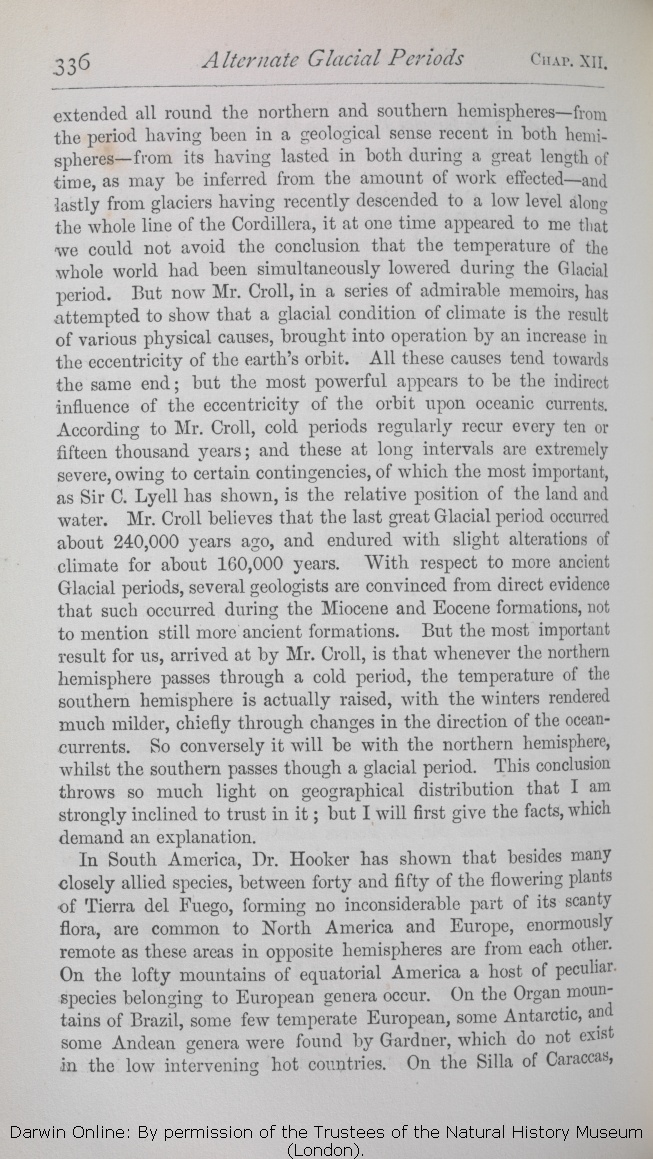extended all round the northern and southern hemispheres— from the period having been in a geological sense recent in both hemispheres— from its having lasted in both during a great length of time, as may be inferred from the amount of work effected— and lastly from glaciers having recently descended to a low level along the whole line of the Cordillera, it
at one time | at one time 1872 |
| formerly 1869 |
| eccentricity 1872 | | excentricity 1869 |
| indirect influence 1872 | | influence 1869 |
| eccentricity 1872 | | excentricity 1869 |
| According to 1872 |
| It follows from 1869 |
| ..... 1872 | | researches, that 1869 |
| and these at long intervals are extremely severe, 1872 |
| but that at much longer intervals the cold, 1869 |
| of which the most important, as Sir C. Lyell has shown, is the relative position of the land and water. 1872 |
| is extremely severe, and lasts for a great length of time. 1869 |
| OMIT 1872 |
| in relation to our present subject, 1869 |
| for us, arrived 1872 |
| arrived 1869 |
| conclusion 1872 | | conclusions 1869 |
| throws so much light 1872 |
| have, as we shall immediately see, a most important bearing 1869 |
| distribution 1872 | | distribution; 1869 |
| am strongly inclined to trust in it; but I will 1872 |
| will 1869 |
| 8 blocks not present in 1869 1872; present in 1859 1860 1861 1866 | | We do not know that the Glacial epoch was strictly simultaneous at these several far distant
points on opposite
sides of the world.
But we have good evidence in almost every case, that the epoch was included within
the latest geological period.
We have, also, excellent evidence, that it endured for an enormous time, as measured by years, at each point.
The cold may have come on, or have ceased, earlier at one point of the globe than at another, but
seeing that it endured for long
at each, and that it was contemporaneous in a geological sense, it seems to me
probable that it was, during a part at least of the period, actually simultaneous throughout the world.
Without some distinct evidence to the contrary, we may at least admit as probable that the glacial action was simultaneous on the eastern and western sides of North America, in the Cordillera under the equator and
under the
warmer temperate zones, and on both sides of the southern extremity
of the continent.
If this be admitted, it is difficult to avoid believing that the temperature of the whole world was at this period simultaneously cooler.
But it would suffice for my purpose, if the temperature was
at the same time lower along certain broad belts of longitude.
On this view of the whole world, or at least of broad longitudinal belts, having been simultaneously colder from pole to pole, much light can be thrown on the present distribution of identical and allied species.
|
|
In
South America, | South America, 1869 1872 | | America, 1859 1860 1861 1866 |
| besides many closely allied species, between 1869 1872 |
| between 1859 1860 1861 1866 |
| North America and Europe, 1869 1872 |
| Europe, 1859 1860 1861 1866 |
| areas in opposite hemispheres are from each other. 1869 1872 |
| two points are; and there are many closely allied species. 1859 1860 1861 1866 |
| Organ 1866 1869 1872 | | highest 1859 1860 1861 |
| temperate European, some Antarctic, and some Andean 1869 1872 |
| European 1859 1860 1861 1866 |
| genera 1859 1860 1861 1869 1872 |
| temperate, some antarctic, and some Andean genera 1866 |
| low 1866 1869 1872 | | wide 1859 1860 1861 |
| countries. 1859 1860 1861 1869 1872 |
| countries; and I have been informed that Agassiz has lately discovered plain marks of glacial action on these same mountains. 1866 |
| On 1866 1869 1872 | | So on 1859 1860 1861 |
|









